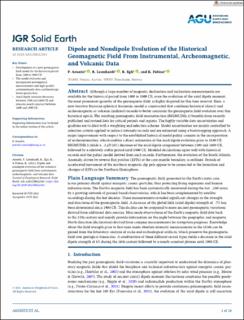| dc.contributor.author | Arneitz, P. | |
| dc.contributor.author | Leonhardt, R. | |
| dc.contributor.author | Egli, R. | |
| dc.contributor.author | Fabian, Karl | |
| dc.date.accessioned | 2022-03-18T07:26:42Z | |
| dc.date.available | 2022-03-18T07:26:42Z | |
| dc.date.created | 2021-11-24T12:14:38Z | |
| dc.date.issued | 2021 | |
| dc.identifier.citation | Journal of Geophysical Research (JGR): Solid Earth. 2021, 126 (10), . | en_US |
| dc.identifier.issn | 2169-9313 | |
| dc.identifier.uri | https://hdl.handle.net/11250/2986009 | |
| dc.description.abstract | Although a large number of magnetic declination and inclination measurements are available for the historical period from 1400 to 1900 CE, even the evolution of the axial dipole moment, the most prominent quantity of the geomagnetic field, is highly disputed for this time interval. Here, a new iterative Bayesian spherical harmonic model is constructed that combines historical (direct) and archeomagnetic or volcanic (indirect) records to better constrain the geomagnetic field evolution over this historical epoch. The resulting geomagnetic field reconstruction (BIGMUDIh.1) benefits from recently published and revised data for critical periods and regions. The highly variable data uncertainties and qualities are tackled with a weighting and selection scheme. Model uncertainties are mainly controlled by selection criteria applied to indirect intensity records and are estimated using a bootstrapping approach. A major improvement with respect to the established historical model gufm1 consists in the incorporation of archeointensities, which enables a direct estimation of the axial dipole evolution prior to 1840 CE. BIGMUDIh.1 yields a urn:x-wiley:21699313:media:jgrb55252:jgrb55252-math-00012 µT (6%) decrease of the axial dipole component between 1500 and 1600 CE, followed by a relatively stable period until 1900 CE. Modeled declinations agree well with historical records and the gufm1 model derived from such records. Furthermore, the evolution of the South Atlantic Anomaly, driven by reverse flux patches (RFPs) at the core-mantle boundary, is outlined. Periods of accelerated movement of the northern magnetic dip pole appear to be connected to the formation and changes of RFPs in the Northern Hemisphere. | en_US |
| dc.language.iso | eng | en_US |
| dc.publisher | American Geophysical Union | en_US |
| dc.title | Dipole and Nondipole Evolution of the Historical Geomagnetic Field From Instrumental, Archeomagnetic, and Volcanic Data | en_US |
| dc.type | Peer reviewed | en_US |
| dc.type | Journal article | en_US |
| dc.description.version | publishedVersion | en_US |
| dc.rights.holder | Locked until 12.4.2022 | en_US |
| dc.source.pagenumber | 16 | en_US |
| dc.source.volume | 126 | en_US |
| dc.source.journal | Journal of Geophysical Research (JGR): Solid Earth | en_US |
| dc.source.issue | 10 | en_US |
| dc.identifier.doi | 10.1029/2021JB022565 | |
| dc.identifier.cristin | 1958338 | |
| cristin.ispublished | true | |
| cristin.fulltext | postprint | |
| cristin.qualitycode | 2 | |
